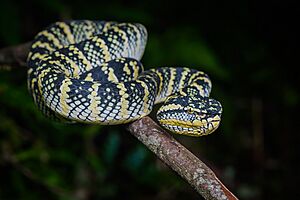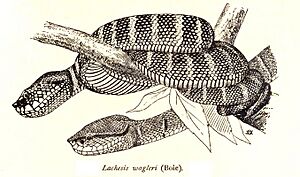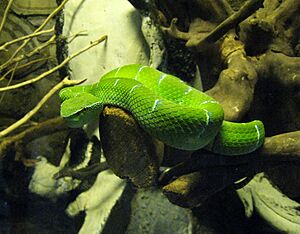Tropidolaemus wagleri facts for kids
Quick facts for kids Tropidolaemus wagleri |
|
|---|---|
 |
|
| Conservation status | |
| Scientific classification | |
| Genus: |
Tropidolaemus
|
| Species: |
wagleri
|
| Synonyms | |
|
|
The Tropidolaemus wagleri, often called Wagler's pit viper, is a type of venomous snake. It belongs to the pit viper group, which is part of the Viperidae snake family. This snake is found only in Southeast Asia. There are no different types (subspecies) of this snake known today. People sometimes call it the temple viper because many of them live near the Temple of the Azure Cloud in Malaysia.
Contents
What's in a Name?
The name wagleri was given to honor Johann Georg Wagler. He was a German scientist who studied reptiles and amphibians.
Meet the Wagler's Pit Viper
Wagler's pit vipers look different depending on if they are male or female. This is called being sexually dimorphic. Female snakes can grow to about 1 meter (39 inches) long. Their bodies are usually black with yellow stripes.
Male snakes are smaller, typically not growing longer than 75 centimeters (30 inches). They have large, triangle-shaped heads and thin green bodies. These snakes spend almost all their time in trees. Their tails can grip branches, which helps them climb easily.
These snakes come in many different colors and patterns. Scientists used to think these different looks meant they were different subspecies. But now we know they are just different "phases" of the same snake. Their colors can range from black or brown with orange and yellow stripes to light green with yellow or orange stripes.
Other Names for the Snake
The Wagler's pit viper has several other common names. These include temple viper, bamboo snake, temple snake, and speckled pit viper.
Where Do They Live?
You can find the Wagler's pit viper in southern Vietnam and southern Thailand. They also live across the Malay Peninsula in west Malaysia and on Penang island. They are found in Singapore and in Indonesia on Sumatra and many nearby islands. These islands include the Riau Archipelago, Bangka, Billiton, Nias, the Mentawai Islands (like Siberut), Natuna, and Karimata.
Scientists have recently studied these snakes more closely. They found that some populations, especially those in the Western Philippines, are actually a different species called T. subannulatus. The true Wagler's pit viper lives mainly in mainland Southeast Asia, Sumatra, and Bangka.
Their Home Environment
Wagler's pit vipers prefer to live in forests. They can be found from sea level up to about 400 meters (1,300 feet) high.
How They Behave
These snakes are active at night (nocturnal) and live in trees (arboreal). They often seem very slow. They stay still for a long time, waiting for food to come by. But if prey appears or if they feel threatened, they can strike very quickly!
What They Eat
Wagler's pit vipers mainly eat rodents, birds, and lizards. They have special "pits" on each side of their head, between their eye and nostril. These pits are amazing! They can sense tiny changes in temperature, as small as 0.003 degrees Celsius (0.0054 degrees Fahrenheit). This helps them find warm-blooded prey even in the dark.
Reproduction and Life Cycle
Female Wagler's pit vipers give birth to live young. This is called ovoviviparity, meaning the eggs hatch inside the mother's body. A mother snake can have anywhere from 15 to 41 babies at one time.
Understanding Their Venom
The venom of the Wagler's pit viper contains special substances called Waglerins. These Waglerins can affect how muscles work. Scientists study these substances to learn more about how the body's signals work.
You might have heard of Waglerin-1 being used in some skin creams. Manufacturers claim it can help reduce wrinkles. However, there is no scientific proof that the Waglerin-1 in these creams actually relaxes the muscles that cause wrinkles.
How Scientists Classify Them
The Wagler's pit viper has been moved around a lot in the scientific classification system. It was once placed in the genus Trimeresurus. But its unique body features and venom are quite different from other snakes in that group. So, scientists created a new genus, Tropidolaemus, just for this snake and Hutton's viper (Tropidolaemus huttoni).





